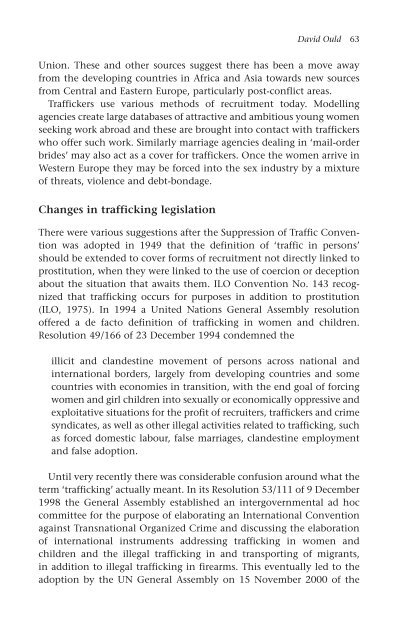3071-The political economy of new slavery
3071-The political economy of new slavery
3071-The political economy of new slavery
Create successful ePaper yourself
Turn your PDF publications into a flip-book with our unique Google optimized e-Paper software.
David Ould 63<br />
Union. <strong>The</strong>se and other sources suggest there has been a move away<br />
from the developing countries in Africa and Asia towards <strong>new</strong> sources<br />
from Central and Eastern Europe, particularly post-conflict areas.<br />
Traffickers use various methods <strong>of</strong> recruitment today. Modelling<br />
agencies create large databases <strong>of</strong> attractive and ambitious young women<br />
seeking work abroad and these are brought into contact with traffickers<br />
who <strong>of</strong>fer such work. Similarly marriage agencies dealing in ‘mail-order<br />
brides’ may also act as a cover for traffickers. Once the women arrive in<br />
Western Europe they may be forced into the sex industry by a mixture<br />
<strong>of</strong> threats, violence and debt-bondage.<br />
Changes in trafficking legislation<br />
<strong>The</strong>re were various suggestions after the Suppression <strong>of</strong> Traffic Convention<br />
was adopted in 1949 that the definition <strong>of</strong> ‘traffic in persons’<br />
should be extended to cover forms <strong>of</strong> recruitment not directly linked to<br />
prostitution, when they were linked to the use <strong>of</strong> coercion or deception<br />
about the situation that awaits them. ILO Convention No. 143 recognized<br />
that trafficking occurs for purposes in addition to prostitution<br />
(ILO, 1975). In 1994 a United Nations General Assembly resolution<br />
<strong>of</strong>fered a de facto definition <strong>of</strong> trafficking in women and children.<br />
Resolution 49/166 <strong>of</strong> 23 December 1994 condemned the<br />
illicit and clandestine movement <strong>of</strong> persons across national and<br />
international borders, largely from developing countries and some<br />
countries with economies in transition, with the end goal <strong>of</strong> forcing<br />
women and girl children into sexually or economically oppressive and<br />
exploitative situations for the pr<strong>of</strong>it <strong>of</strong> recruiters, traffickers and crime<br />
syndicates, as well as other illegal activities related to trafficking, such<br />
as forced domestic labour, false marriages, clandestine employment<br />
and false adoption.<br />
Until very recently there was considerable confusion around what the<br />
term ‘trafficking’ actually meant. In its Resolution 53/111 <strong>of</strong> 9 December<br />
1998 the General Assembly established an intergovernmental ad hoc<br />
committee for the purpose <strong>of</strong> elaborating an International Convention<br />
against Transnational Organized Crime and discussing the elaboration<br />
<strong>of</strong> international instruments addressing trafficking in women and<br />
children and the illegal trafficking in and transporting <strong>of</strong> migrants,<br />
in addition to illegal trafficking in firearms. This eventually led to the<br />
adoption by the UN General Assembly on 15 November 2000 <strong>of</strong> the


